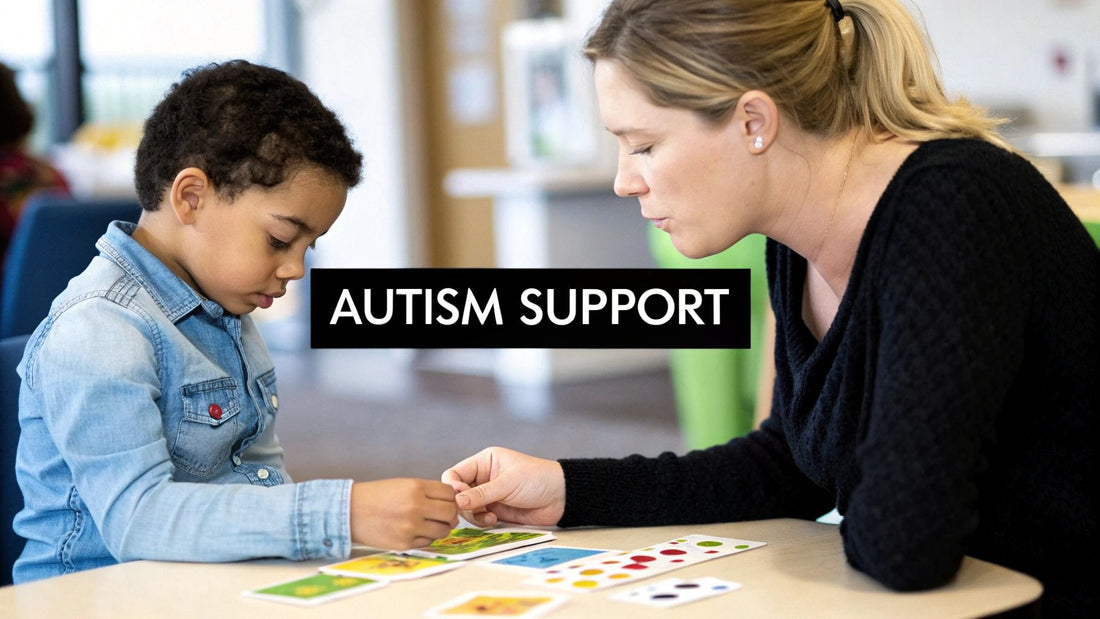
Supporting Children with Autism: A Practical Guide
Share
To truly support an autistic child, you first have to commit to understanding their unique world. It's less about viewing autism as a list of challenges to "fix" and more about recognising it as a different, entirely valid way of experiencing life. This means stepping past the stereotypes to really appreciate their sensory realities, how they communicate, and their deep, passionate interests.
Understanding an Autistic Child's World
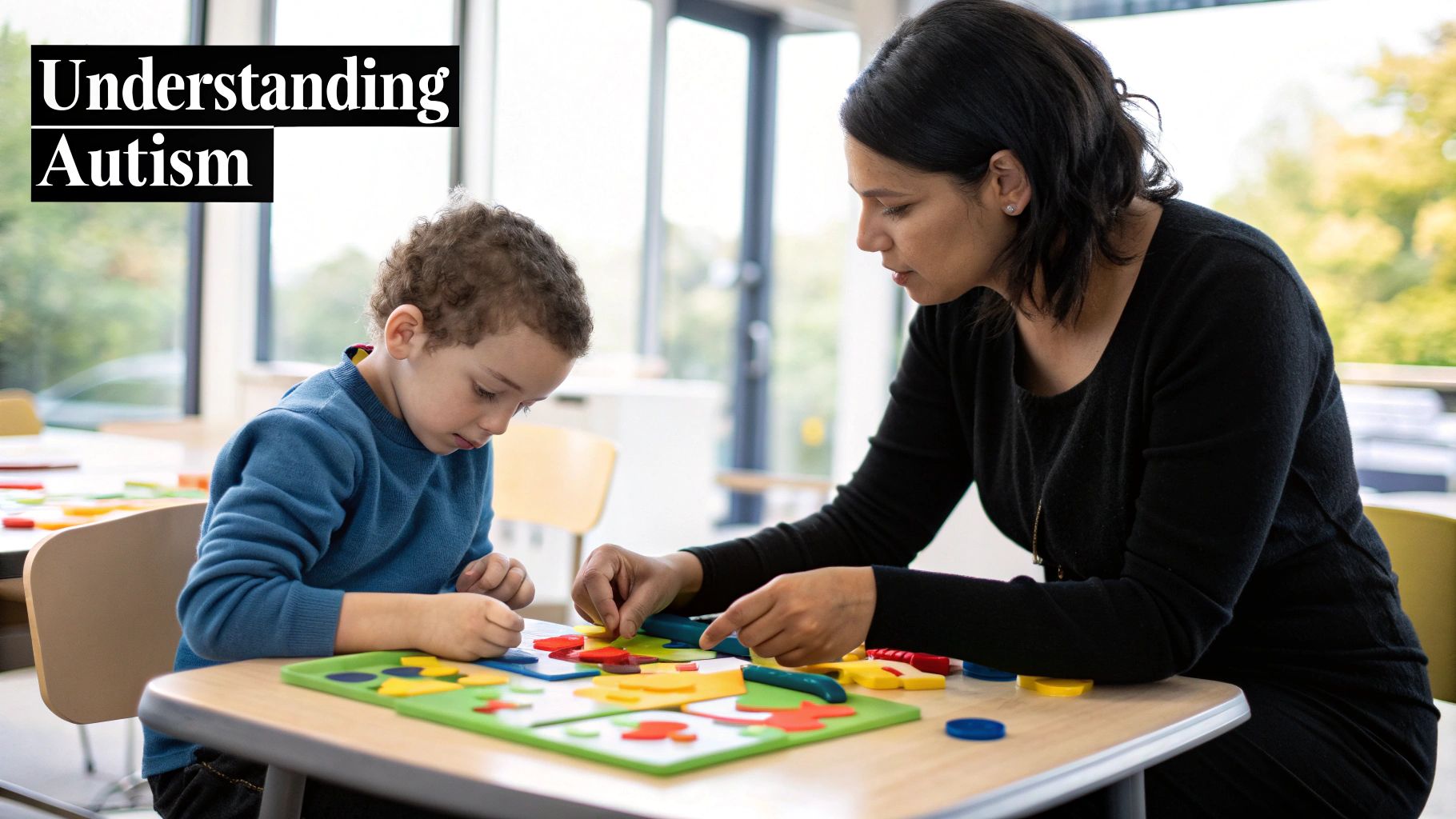
If you want to offer genuine support, the first step is trying to see the world through their eyes. A behaviour that looks confusing from the outside is often a perfectly logical response to what’s happening on the inside. Empathy is everything. It shifts your focus from correcting behaviour to building a real connection.
This means looking for the why. A child flapping their hands isn't necessarily "misbehaving"; they might be expressing pure joy or trying to regulate an overwhelming sensory input. In the same way, a child who avoids eye contact isn't being rude. They might find it intensely uncomfortable, and looking away actually helps them listen and process what you’re saying without that direct visual pressure.
The Importance of Mental Health Awareness
The link between autism and mental health is something we cannot ignore. Research shows that autistic children are more likely to also experience conditions like anxiety and depression. This isn't a personal failing; it’s often the result of trying to navigate a world that wasn't designed for their neurological make-up. The constant pressure to "mask" or hide their natural autistic traits to fit in is mentally exhausting and can be incredibly damaging over time.
That's why addressing mental health from an early age is so important. For children, these challenges can look different than they do in adults. You might see it as irritability, pulling back from social situations, or big changes in their sleeping or eating patterns. The statistics are stark: in 2023, it was found that one in five children and young people aged 8 to 25 had a probable mental health condition. Raising public awareness through initiatives like Autism Awareness Month is a huge step toward building a more inclusive and understanding society.
It's important to remember that I am not a mental health professional. The insights and tips shared here are for guidance and support. If you have serious concerns about your child's mental wellbeing, it is essential to seek advice from your GP or a qualified mental health professional.
Practical Examples and Modern Pressures
Social media can be a particularly tricky space to navigate. The curated "perfection" and unspoken social rules on these platforms can crank up feelings of anxiety and isolation for autistic young people, who often process social cues much more literally.
And it’s not just an individual issue. The wider economic impact is significant. In the UK, poor mental health costs businesses an estimated £56 billion a year due to lost productivity and absenteeism. By helping children build good mental health habits and emotional understanding now, we’re investing in healthier, more resilient adults for the future.
Simple relaxation techniques can be a game-changer. For example, you could try:
- Deep, slow breathing exercises, like pretending to blow out birthday candles.
- Creating a quiet corner with soft lighting and cosy blankets.
- Using a weighted blanket to help them feel grounded and secure.
Exploring tools that encourage self-expression is also fantastic. Reading age-appropriate mental health books together can open up conversations about feelings in a safe way. Even something as simple as mental health apparel with positive affirmations can help normalise these discussions and make it easier for a child to express themselves.
Developing a child’s ability to understand and express their feelings is a foundational skill. We have a detailed guide explaining what is emotional literacy if you want to learn more. Building this vocabulary gives them the power to tell you what they need, which can cut down on frustration and anxiety for everyone.
Creating a Calm and Predictable Environment
For many autistic children, the world can feel chaotic and overwhelming. Change, even small shifts in routine, can be deeply unsettling, often leading to heightened anxiety that makes it hard to process information or learn new things.
That's why one of the most powerful things we can do is create a calm, structured, and predictable environment. This isn’t about being overly rigid; it's about providing a sense of safety and security that allows a child to truly flourish. Think of it as an external organiser, helping them understand what’s happening now and what to expect next. This simple act can reduce their mental load, freeing up precious energy for learning, playing, and connecting with others.
This infographic breaks down the core elements of building a supportive space at home or in the classroom.
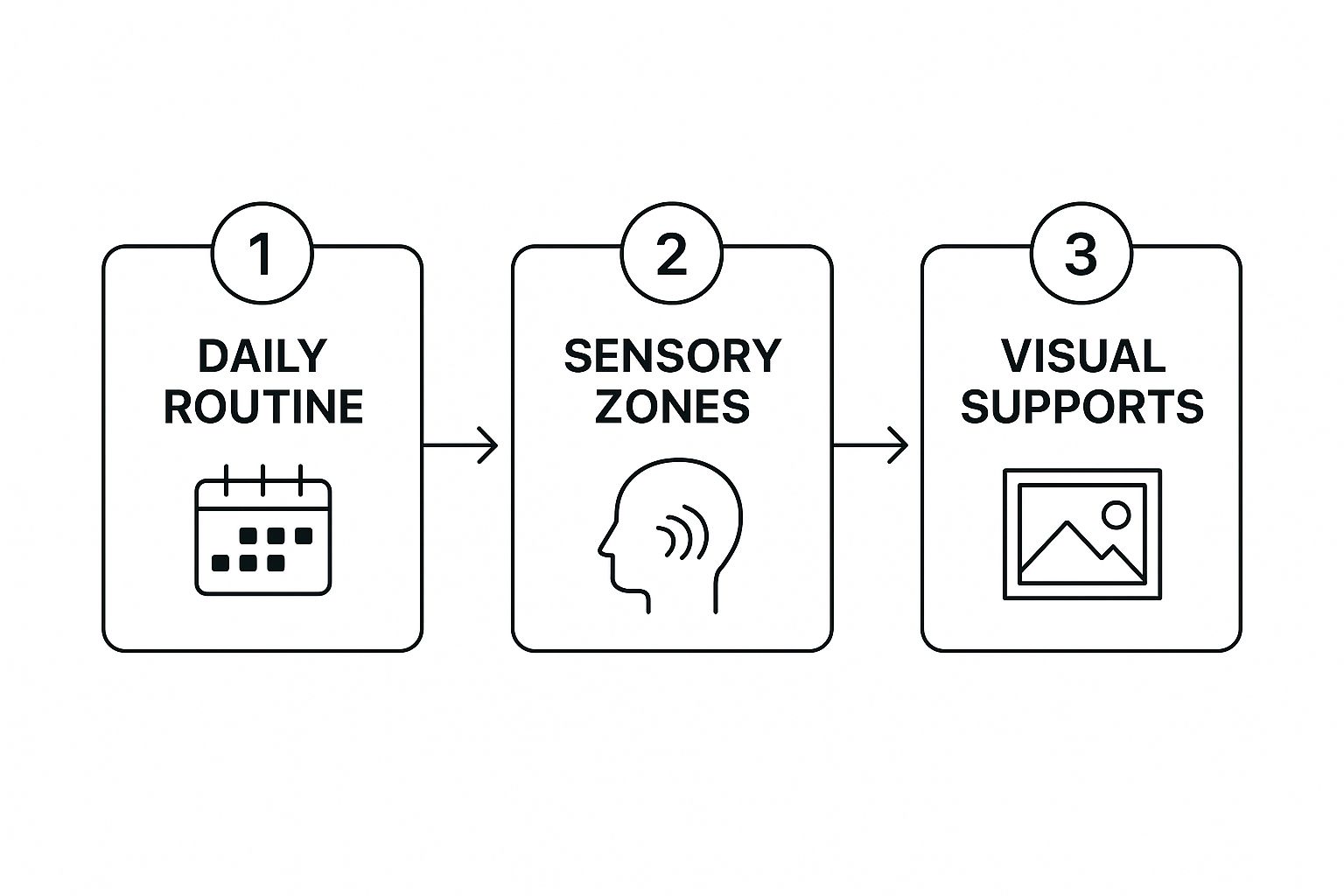
As you can see, establishing routines, managing sensory input, and using visual aids all work together to build a secure foundation for the child.
The Power of Visual Supports
Processing spoken language can be a real challenge for many autistic individuals, especially when they're feeling stressed or overwhelmed. Words can disappear as soon as they're spoken.
Visual supports, on the other hand, make abstract concepts like 'time' or verbal instructions concrete and permanent. They stick around, allowing a child to check them as many times as they need to, which is a fantastic way to promote independence.
Here are a few practical examples you can start using today:
- Visual Timetables: A sequence of pictures showing the main activities for the day (e.g., breakfast, get dressed, go to school). This instantly answers that all-important question: "What's happening next?"
- Now-and-Next Boards: A simplified version that just shows the current activity and the one immediately following. It’s brilliant for focusing on a single transition, like "Now: finish homework, Next: tablet time."
- Social Stories™: These are short, simple stories that explain a social situation and suggest what to expect or how to respond. A story about visiting the dentist, for example, can prepare a child by walking them through each step, from the waiting room to the dentist looking at their teeth.
The key here is consistency. For these tools to work their magic, they need to be used consistently across different places, like home and school. When a child sees the same visual cues in different settings, they learn to trust them as a reliable source of information.
Managing the Sensory Environment
An autistic child’s sensory experience of the world can be wildly different from a neurotypical person's. What sounds like quiet background noise to you might feel like a deafening roar to them. Supporting an autistic child means becoming a detective of their sensory world.
Start by simply observing. What are their specific sensory sensitivities? Do they cover their ears when the hoover is on? Do they retreat from bright lights or strong smells? On the flip side, what sensory input do they actively seek out? Do they love the deep pressure of a tight hug or the repetitive motion of swinging?
Once you have this insight, you can make simple but incredibly effective changes:
- Lighting: Swap harsh fluorescent bulbs for warmer, calmer lighting. Dimmer switches and lamps are your friends.
- Sound: Offer noise-cancelling headphones for loud places. A white noise machine can also help to mask sudden, jarring sounds at home.
- Space: Create a designated 'safe space' or 'calm corner'. This should never be a punishment area! Instead, it’s a cosy nook with soft pillows, a weighted blanket, or favourite sensory toys where they can retreat to self-regulate when things get too much.
To give you a quick-reference guide, here are some core strategies you can implement to make any environment more supportive.
Core Environmental Support Strategies
| Strategy | What It Is | Why It Helps |
|---|---|---|
| Visual Timetables | A sequence of images or symbols showing the day's activities. | Reduces anxiety about the unknown by making the day predictable. |
| Quiet/Calm-Down Corner | A designated safe space with comforting items like blankets or sensory toys. | Offers a private area for self-regulation when feeling overwhelmed. |
| Sensory Toolkit | A box of sensory items like fidget toys, headphones, or scented putty. | Provides immediate access to tools that help manage sensory input. |
| Consistent Routines | Sticking to a regular schedule for daily activities (meals, bedtime, etc.). | Creates a feeling of safety and security; the child knows what to expect. |
| Clear, Simple Language | Using direct, concise instructions and avoiding sarcasm or idioms. | Reduces the cognitive load of interpreting complex language. |
| Transition Warnings | Giving a heads-up (e.g., "Five more minutes") before an activity changes. | Helps the child mentally prepare for a shift, making transitions smoother. |
Making these adjustments sends a powerful message: their experience is valid, and their comfort matters. It helps them feel understood and gives them the tools to manage their own regulation.
The need for this kind of support is widespread. In the UK, it's estimated that at least 1 in 100 people are on the autism spectrum. You can read more about the prevalence of autism from the National Autistic Society. This highlights just how many children can benefit from these tailored approaches in their everyday lives.
Fostering Connection Through Communication
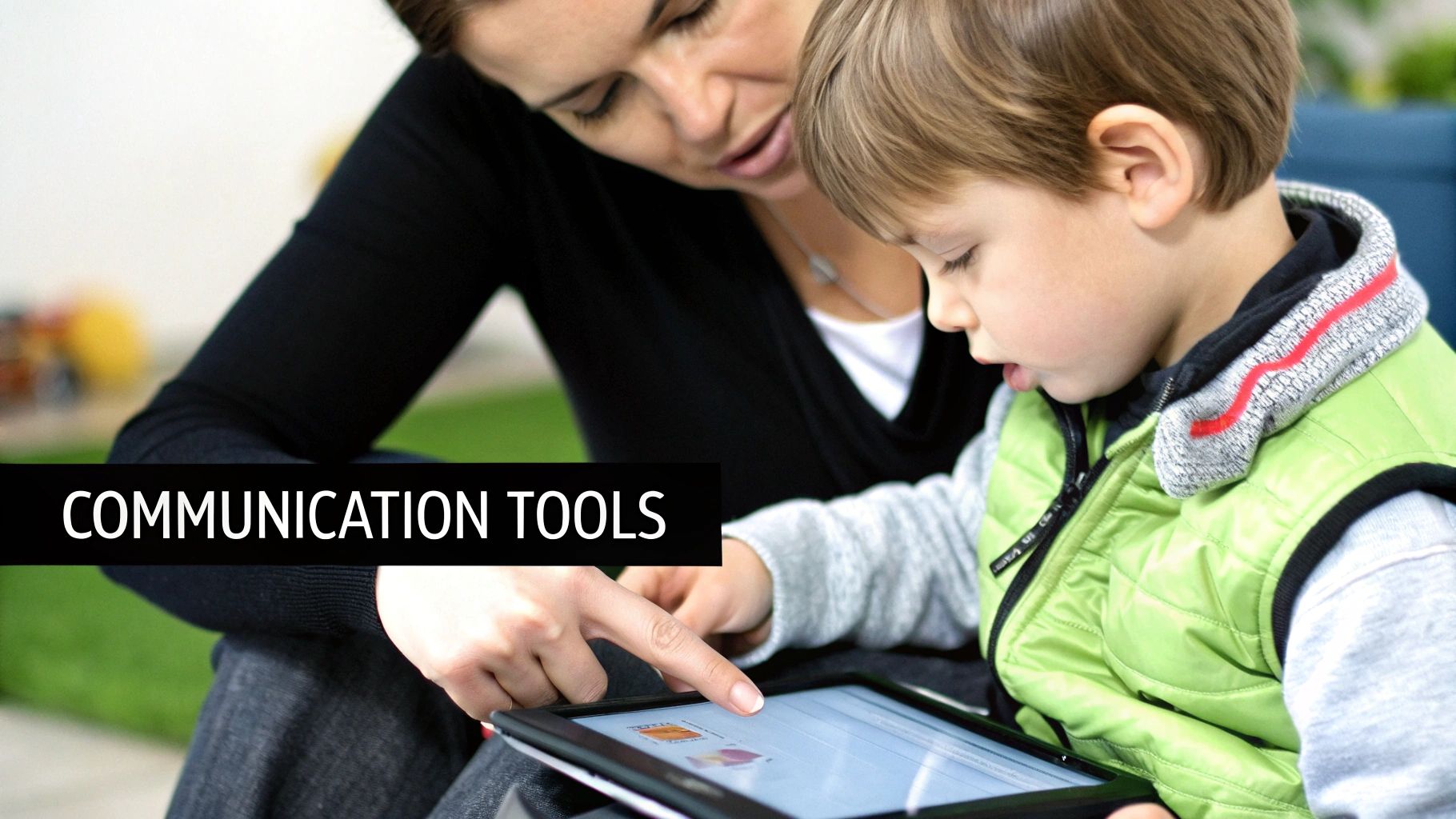
A real, genuine connection with an autistic child starts with understanding and respecting their unique way of communicating. It’s about looking beyond spoken words and valuing every single attempt they make to connect, whether that's through a gesture, a sound, or a communication tool.
When we shift our own perspective, we start to see that communication isn't just about talking. For many autistic children, it's about finally being heard and understood in whatever way feels most natural to them. This simple change in approach builds incredible trust and lifts the immense pressure they often feel to fit into a neurotypical mould.
Speaking Their Language
One of the most powerful things you can do is to use clear, direct, and literal language. Figurative speech, like idioms ("it's raining cats and dogs") or sarcasm, can be genuinely baffling because they are often taken at face value.
Just imagine someone telling you to "pull your socks up" when you're already wearing them perfectly well. It creates a layer of confusion and anxiety that's completely unnecessary. Instead, saying exactly what you mean—like, "It's time to focus on your homework now"—removes any doubt and helps the child process the request without the added stress. Keeping your sentences short and giving them a little extra time to process can also make a huge difference.
This isn't about being blunt or rude; it's a form of respect. You're showing them you're willing to adapt your communication to meet their needs, which is a powerful way to build a stronger relationship.
Embracing All Forms of Communication
So much of communication isn't verbal, and it’s absolutely vital to recognise and value every kind of expression. Alternative and Augmentative Communication (AAC) is the term for all the tools and strategies that can be used alongside or instead of speech. These aren't a last resort; they are the key to unlocking a child's voice.
Here are a few powerful AAC tools you might come across:
- Picture Exchange Communication System (PECS): This system uses pictures to help a child communicate their wants and needs. They might hand you a picture of a juice box, for instance, to ask for a drink.
- Communication Apps: A tablet or phone can be an incredible communication partner. Apps loaded with symbols and text-to-speech functions allow a child to build sentences and have their thoughts spoken aloud.
- Sign Language: Simple sign languages, such as Makaton, can be a brilliant way for children to express core concepts and feelings, cutting down on frustration for everyone.
When we value these methods, we treat them with the same importance as spoken language. If a child uses an AAC device to talk to you, give them your full attention, just as you would in any other conversation. This simple act validates their voice and empowers them to share their rich inner world with you.
The world of autism support is always changing. For example, ongoing assessments in regions like Northern Ireland highlight just how dynamic the needs of autistic children are. Because autism is a spectrum, the level of support a child needs can vary enormously; some children grow to be highly independent, while others require lifelong specialist care. You can find out more about the evolving need for support pathways by looking at the latest quarterly autism statistics for NI.
Building Social Skills Through Shared Joy
Teaching social skills shouldn't feel like a sterile, clinical exercise. The most genuine and lasting social learning happens when it’s built around a child’s own passions and intense interests.
If a child absolutely adores trains, use that! You can build social skills by taking turns adding a piece to the track, commenting on each other's work ("I love your bright green carriage!"), or planning a trip to a railway museum together. This approach is far more meaningful and effective than forcing interactions in situations that hold zero interest for them.
By focusing on shared joy, you're helping them build real friendships based on common ground. It also reduces the need for masking—that exhausting process of hiding autistic traits just to fit in. Masking is a massive contributor to anxiety and burnout, so creating spaces where a child can be their authentic self is one of the kindest things we can do for their long-term mental health. Exploring our recommended books for autistic children can be a wonderful way to create shared experiences and gently open up conversations about different social situations.
Nurturing Emotional Wellbeing and Resilience
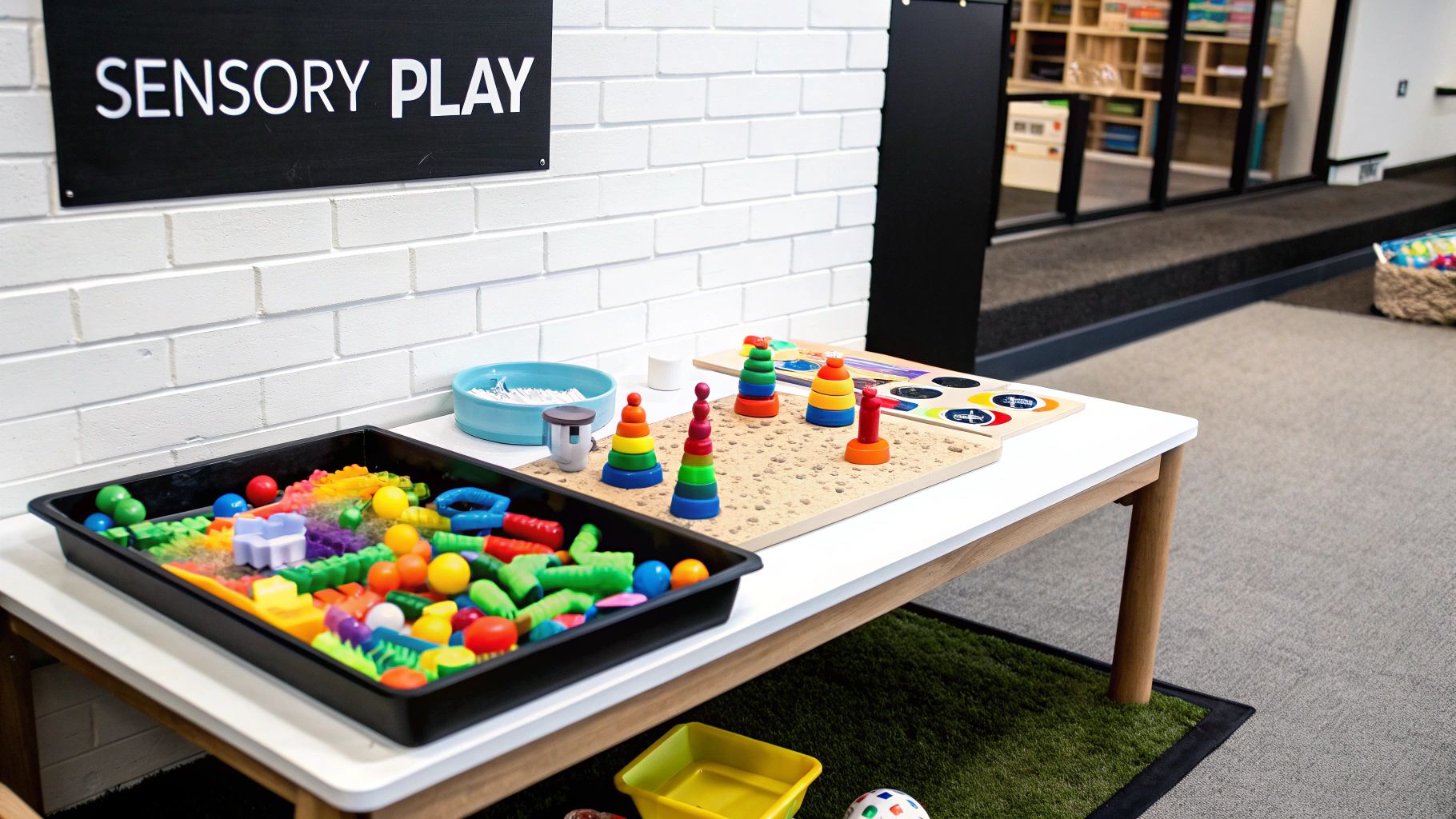
An autistic child's mental health is the foundation for everything else. Without feeling emotionally secure and resilient, learning and connecting with others becomes incredibly difficult. Prioritising their emotional wellbeing is genuinely one of the most powerful ways of supporting children with autism.
Before we go any further, it’s really important to state that I am not a mental health professional. The ideas I’m sharing here are meant to be practical, supportive tools for parents and caregivers. They are absolutely not a substitute for professional medical advice.
If you have serious concerns about a child's mental or emotional state, it is crucial to contact your GP or a qualified mental health professional. They can provide a proper assessment and guide you towards the most appropriate support for your child's specific needs.
Understanding the Mental Health Landscape
The statistics around children's mental health in the UK are pretty sobering. Recent data shows that one in five children and young people aged 8 to 25 had a probable mental health condition in 2023. For autistic children, this risk can be even higher, often because of the constant stress of trying to navigate a world that wasn't built for them.
This emotional toll has real-world effects. Beyond the personal impact, poor mental health costs UK businesses an estimated £56 billion annually through lost productivity. By nurturing resilience in our children today, we’re helping to foster a healthier, more capable workforce for the future.
The rise of social media adds another layer of challenges. The pressure to fit in and the unwritten social rules of online platforms can be especially confusing and anxiety-inducing for autistic young people, who might take communication very literally.
Practical Strategies for Building Resilience
Building emotional literacy—the ability to recognise, understand, and talk about feelings—is a vital skill. It gives a child the vocabulary to tell you about their inner world, which can reduce frustration and help prevent emotional overwhelm.
Simple tools can make a huge difference:
- Emotion Cards or Charts: Visual aids with faces showing different emotions are brilliant for helping a child connect a name to a feeling. You can point to the 'sad' face and say, "It looks like you feel sad right now. Is that right?"
- Storybooks: Books are a fantastic, gentle way to explore complex feelings. For example, stories from Little Fish Books can open up safe conversations about feelings like jealousy or anxiety by exploring them through relatable characters. You can explore a curated list of mental health books that are perfect for starting these conversations.
- Mental Health Apparel: It might seem like a small thing, but mental health apparel with positive affirmations can help normalise these conversations within the family and community. It makes it that little bit easier for children to talk openly.
It's also worth remembering that supporting a child's physical health through good nutrition is closely linked to their mental wellbeing. For guidance on ensuring your child gets the right nutrients, you might find some useful information on finding the best vitamins for children.
Simple Relaxation Techniques
Teaching a child how to calm their own body is an invaluable life skill. When they're feeling overwhelmed, their nervous system goes into high alert, making logical thinking almost impossible. Relaxation techniques can help bring them back to a calmer state.
Try introducing these simple practices during quiet, calm moments. That way, they’ll become familiar tools your child can turn to during stressful times.
- Deep Belly Breathing: Ask them to place a hand on their tummy and feel it rise and fall like a balloon as they breathe in slowly through their nose and out through their mouth.
- Weighted Blankets or Lap Pads: The deep pressure from a weighted blanket can have an incredibly calming effect on the nervous system, helping a child feel grounded and secure.
- A 'Calm-Down Corner': As we've mentioned before, having a designated safe space with comforting things like soft blankets, sensory toys, or calming books empowers a child to self-regulate when they feel overwhelmed.
These techniques, combined with an open dialogue about feelings, help build a solid foundation of emotional resilience, equipping autistic children with the tools they need to navigate life's challenges with greater confidence.
Getting to Grips with UK Education and Support
For any parent, trying to secure the right educational support for their child can feel like a full-time job. The systems across the UK, though meant to help, are often a maze of confusing acronyms and processes. But getting your head around the framework is the first and most important step to becoming your child's best advocate, making sure they get the support they're legally entitled to.
This guide is here to help cut through the noise. We'll break down what you need to know about getting an Education, Health and Care Plan (EHCP) in England, or the equivalent plans in Scotland, Wales, and Northern Ireland. The goal is to give you the confidence to navigate the bureaucracy.
What is Special Educational Needs (SEN) Support?
Before any formal plans are put in place, schools across the UK are expected to provide a baseline level of help for any child identified with special educational needs. This is usually called SEN Support. It's designed as a graduated approach, which simply means the school should be constantly checking in and tweaking the support they offer.
It’s a four-part cycle that looks something like this:
- Assess: The school, usually spearheaded by the Special Educational Needs Coordinator (SENCO), works to pinpoint your child's needs.
- Plan: Working with you and your child, the school draws up a plan of action.
- Do: The plan is put into practice by teachers and support staff.
- Review: Everyone gets together to see how effective the plan has been, and adjustments are made for the next cycle.
It’s so important to work closely with the SENCO and your child’s teachers at this stage. Keep a folder—digital or physical—of every email, meeting note, and agreed action. If you're looking for more pointers, there are plenty of helpful essential SEN resources to support special education needs out there.
The Education Health and Care Plan (EHCP)
What happens if the standard SEN Support isn't enough to meet your child's needs? The next step is to request an EHC needs assessment. An Education, Health and Care Plan (EHCP) is a legally binding document in England that details a child's educational, health, and social care needs, along with the specific support required to meet them.
Anyone can ask the local authority for an assessment, including parents, but it usually works best when you partner with the school. Once the request is in, the local authority has six weeks to decide whether to go ahead with it.
Being a strong advocate is everything. When you're getting ready for meetings, gather all your documents in one place: school reports, letters from doctors or therapists, and your own detailed notes about your child's strengths and struggles. Being organised shows you're a serious partner in this process.
Things are a bit different depending on where you are in the UK. In Wales, the equivalent is an Individual Development Plan (IDP). Scotland has a Co-ordinated Support Plan (CSP), although the criteria for getting one are notoriously strict. Over in Northern Ireland, a Statement of Special Educational Needs serves a similar purpose.
Support Systems Across the UK
The number of autistic children in schools really shines a light on how vital these support systems are. Take Northern Ireland, for example. The estimated prevalence of autism among school-aged children was 5.9% in the 2024/25 school year. That’s almost 6 in every 100 children identified as autistic.
What's particularly interesting is that 18% of these autistic children had no special educational needs recorded, while 63% were at Stage 3 of SEN Assessment, which means they have a formal Statement of SEN. You can read more about these autism prevalence statistics in Northern Ireland.
Common Questions About Supporting Autistic Children
When you're finding your way in the world of autism support, it’s natural for questions to pop up. This final section is all about giving you clear, practical answers to some of the most common things we hear from parents and educators, building on everything we’ve talked about so far.
How Can I Best Support My Child During a Meltdown?
The first thing to hold onto is that a meltdown isn't a tantrum. It’s a complete and intense response to being utterly overwhelmed.
Your role is to be a calm anchor. Reduce the sensory input around them – maybe dim the lights or turn down the volume on the TV – and make sure they’re in a safe space. This isn't the time for reasoning or talking it through. Often, your quiet, steady presence is the most powerful support you can offer.
What Should I Look for in a School?
You’re looking for a school with a genuine culture of inclusion, not just one that ticks a box. Dig a little deeper and check out their SEN (Special Educational Needs) department.
Ask them directly about their staff training on autism, how they handle sensory needs in a busy classroom, and what they do to help create social opportunities. A good school will be excited to collaborate with you and will see you as a vital partner in your child's education.
How Can I Help My Child Make Friends?
Friendships almost always grow from shared interests. Instead of aiming for big, unstructured playdates which can feel chaotic, try something smaller and more focused.
Think about what your child loves. Could you organise a small Lego-building session? A trip to a train museum with one other child? This creates a much more natural, low-pressure environment where a real connection can spark.
Important Reminder: I am not a mental health professional. The advice shared in this guide is for informational purposes only. If you have significant concerns about your child's mental or emotional wellbeing, it is essential to seek guidance from your GP or a qualified professional.
My Child is a Very Picky Eater. What Can I Do?
Picky eating is so often tied to sensory sensitivities. The texture, smell, or even the look of a certain food can feel completely overwhelming.
The key is to remove the pressure. Try introducing a new food by placing a tiny amount next to something familiar and loved on their plate. Keep mealtimes as relaxed as possible and offer gentle praise for any interaction, even if it's just touching the new food. It’s all about small, positive steps.
How Should I Address Mental Health?
Talking openly and honestly about feelings is one of the most important things we can do. It’s crucial to realise that mental health challenges are incredibly common. Studies from 2023 showed that one in five children and young people experienced a probable mental health condition. This isn't a small issue; poor mental health costs UK businesses up to £56 billion a year.
You can start at home by introducing simple relaxation techniques, like deep breathing exercises, or creating a dedicated calm-down corner. The modern world, with all its pressures from things like social media, can be especially tough for autistic children. Just normalising conversations about these feelings and pressures makes a massive difference.
You can also use tools designed to build that all-important emotional literacy:
- Mental Health Books: Stories are a wonderfully gentle and non-threatening way to start exploring complex emotions together.
- Mental Health Apparel: Sometimes, clothing with a positive message can be a simple conversation starter and help reduce any stigma around talking about feelings.
When you create a safe space for these conversations, you empower your child to ask for help when they need it. You're helping them build a foundation for lifelong emotional resilience.
At Little Fish Books, we are dedicated to providing resources that nurture emotional literacy and support the mental wellbeing of children and young people. Explore our collection of books, activities, and merchandise designed to help youths recognise, express, and manage their feelings by visiting our website.
